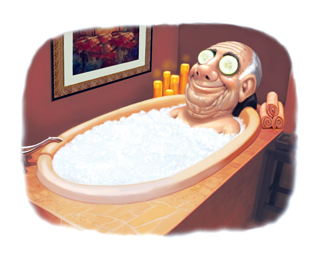
Resident bathing is becoming much more than an exercise in hygiene. What was once seen as a rudimentary chore that residents and staff wanted to complete as fast as possible, the process of getting clean is becoming a more enjoyable process in the assisted living environment, bathing specialists say.
David Anderson, national sales manager at Apollo Bath, says the state of bathing in senior housing has been undergoing an evolution for about the past 20 years and continues to improve.
“Visit any facility today and you will likely see ‘Spa Room’ on the door entering the bathing area,” he says. “This is because while the primary purpose of bathing systems is for hygiene, today’s facilities want to provide a more relaxing and enjoyable spa experience.”
The bathing process has historically been an area that poses a variety of challenges for assisted living facilities. The chief concern, naturally, is safety. But providing comfort, relaxation and aesthetics is also essential to a first-rate experience, says Rachelle L. Congdon, vice president of marketing for MasterCare.
“More facilities ‘get it’ with regard to bathing,” she says. “This is an exciting trend toward developing communities that serve to transform lives by providing luxury and resort-style amenities and atmosphere. It is really gratifying to know that we are finally transforming bathing by putting more emphasis on physical, emotional and spiritual well-being of seniors and physically frail individuals.”
Fran Spidare, product development manager for safe patient handling at Invacare, also sees tremendous improvements in bathing operations.
“Many now understand the importance of creating a relaxing bathing environment,” she says. “They balance the time required for true hygiene with the time for relaxing in the physical and emotional warmth of the total environment. We are seeing more centers with beautifully designed bathing areas.”
Creating ambience
Adding aesthetic elements to the bathing experience are the touches that offer a truly inviting environment. But it starts with creating an area that is designed to accommodate bathing, Spidare says.
“The bathing tub is especially important as it provides easy access for clients of every physical condition, with hydro jets that actually move the water,” she says. “This movement of warm water relaxes the muscles. These jets should not constrain the use of bath oil, bath salts, or the client’s favorite soaps and shampoos. What good is a relaxing bath without your favorite soap?”
Color also is an important part of the spa design scheme and more facilities have become creative in deploying it, says Lee Penner, president of Penner Patient Care.
“If the facility has an interior decorator, we can work with them,” he says. “If they have chosen the décor, we can create something that will match. We will provide custom colors and granite-like textures. By using color, you can create a spa that blends well with the room so it looks built in, not sterile and institutional.”
Some Penner units have a TV built into the cabinetry so that residents can watch their favorite DVDs while bathing.
Congdon condones using ambience-inducing elements, such as aromas, lighting and music.
“Aromatherapy — a standard feature on MasterCare tubs — is a nice way to offer that soothing scented, relaxing environment without lighting a candle, which is restricted in many communities,” she says.
Another key to pleasant bathing is planning ahead, Congdon says.
“Know about the residents you’re bathing and their preferences,” she says. “Having all toiletries, soaps and lotions each resident likes readily available is essential, as are a soft wash cloth, warm towel, fresh set of clothes or robe.”
Safety concerns
Without sound safety procedures, none of the cosmetic bathing attributes matter, specialists say. One of the preeminent safety measures should be preventing slippery surfaces, Spidare says.
“Keeping the floor as dry as possible is key to a safe environment for caregivers and clients alike,” she says. “This goes back to the design of the room — the floor should be slightly sloped to allow for good drainage. Rubber mats should be used to provide traction and slip resistance.”
Bath entry and exit can be hazardous and the process should be handled with extreme care, Congdon says. Making certain the bathing room is warm is another good idea, because being cold can lead to hurrying, which leads to slips.
“Getting out of the tub is especially important because the resident is wet and needs to be as dry as possible,” she says. “Standing on a dry towel or clean bath mat will help prevent slipping. Also, providing a tub with a chair or transfer device so there is no stepping is also helpful.”
Infection control is another vital safety procedure due to the risk of cross-contamination and nosocomial pathogens, Anderson says.
The privacy factor
Creating an air of dignity and privacy is another critical facet of a first-rate bathing operation. While the ideal environment is to have a bathing area with a single whirlpool system, a toilet and sink for one occupant, Anderson concedes it’s not always possible.
“While the trend now is to call the bathing area the ‘spa room,’ these are still centralized bathing systems and the resident population needs to be considered,” he says. “A qualified staff member should always be present to assist with the bath process and deal with any potential issues that may arise.”
From the February 01, 2015 Issue of McKnight's Senior Living



